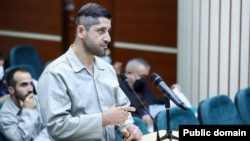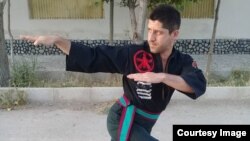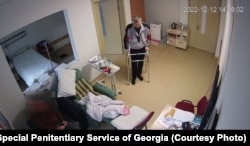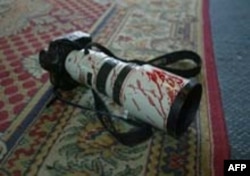
While Mohammad Hosseini's execution was intended as a message from Tehran that involvement in ongoing antiestablishment protests will not be tolerated, his memory lives on as a victim of state repression.
The 39-year-old poultry worker and community-minded coach had no support from those closest to him as he faced charges of killing a member of Iran's paramilitary forces as mourners demonstrated in a city outside the Iranian capital in November.
After being found guilty of "corruption on Earth" in a rushed trial, Hosseini received no visits from friends and relatives as he sat on death row. Nobody, not even his three siblings, pleaded publicly for his life to be spared before he was hanged in early January, and reports suggest that no one immediately claimed his body.
His brother, with whom Hosseini did not have a close relationship, was given his body only after he promised "not to speak to anyone and bury him in silence" sources told RFE/RL's Radio Farda.
But in the weeks following his death, Hosseini has been increasingly embraced by supporters who see themselves as "mothers," "brothers," and "sisters" of a victim of state repression who lived a simple life, dealt with medical conditions, and gave to the community by training impoverished children in the martial arts.
Hosseini was hanged on January 7 along with 22-year-old Mohammad Mehdi Karimi. The two were convicted for the November 3 killing of Basij militia member Ruhollah Ajamian in Karaj, a city just west of Tehran.
Authorities said Ajamian died from multiple blows from "knives and other hard objects, including stones" allegedly delivered by a group of mourners marking 40 days since the death of a demonstrator. The slain protester is just one of more than 500 victims of Iran's violent crackdown on the mass demonstrations that broke out in over 100 cities across the country following the death in police custody of Mahsa Amini in September. The 22-year-old woman had been detained for allegedly not wearing her hijab, or head scarf, properly.
According to the Iranian authorities, Ajamian was unarmed when he was attacked while attempting to open a road closed by the mourners.
Hosseini and Karimi, who were sentenced to death following a fast-tracked trial in which they were not given access to legal representation of their choice, each denied the allegations against them.
Their trial lasted less than a week and relied on confessions the men gave under torture, according to Amnesty International, which noted that state media aired potentially damning video testimony even before their case got to court.
Hosseini, who reportedly dealt with bipolar disorder, was shown saying that he was on his way to the cemetery in Karaj to visit his parents' graves when he saw "a young man who had fallen to the ground."
"Because I have mental issues, I ran away," he said in the video, which also included images of martial arts weapons taken from Hosseini's home as evidence.
"These are for sports, dear," Hosseini said when asked about the weapons.
Allegations Of Torture
In another video also published by state media, he said he spent "less than 10 seconds" at the scene of Ajamian's killing, and suggested that the Basij member was already dead.
Lawyer Mohammad Sharifzadeh Ardakani, who was initially barred from representing Hosseini, said on December 18 that he managed to meet him in prison, where the accused tearfully said he had been tied up, kicked in the head, and shocked with electricity to make him confess to his alleged crimes.
"A person's confession under torture has no legal merit," Ardakani said on Twitter. He was subsequently charged over his comments and released on bail.
Ardakani later said that after Hosseini was convicted he filed for a retrial, but had not managed to convince the court to halt the death sentence. He said he found out about his client's execution as he headed to discuss the case with the authorities.
Details about Hosseini's luckless life led to an outpouring of grief and sadness. A photo taken during his trial where he was seen holding his face in an apparent state of shock and disbelief went viral.
"I think about your loneliness, the mother you didn't have to cry for you, the father who wasn't there to shout your name," journalist Sadaf Fatemi wrote on Twitter.
Gohar Eshghi, the mother of blogger Sattar Beheshti killed in 2001 in the custody of Iran's cyberpolice, called on authorities to hand Hosseini's body over to her. Camelia Sajadian, whose son Hassan Torkman was reportedly killed in Iran's ongoing crackdown on antiestablishment protests, announced that she had arranged for a headstone for Hosseini, referring to him as her "dear son."
Others have visited Hosseini's grave and showered it with flowers, distributed food to the poor in his memory, or offered their condolences with comments on his Instagram page, which quickly gained over 60,000 followers.
"I didn't know you until three weeks ago, I hadn't heard your name and I had no idea who you were. But now I visit your page and cry for you like a sister who has lost a brother," one woman commented under a photo in which Hosseini was shown practicing martial arts.
Hosseini's workplace, by contrast, did not allow any kind of memorial for him, one of his colleagues to Radio Farda, while other sources said he was never informed that his execution was imminent.
"Usually prisoners [on death row] are taken to solitary confinement the night before their hanging, but Hosseini was not taken to a solitary cell," one source told Radio Farda on condition of anonymity. "[The authorities] did not want anyone to find out that he was about to be executed."
Hosseini is one of four people who have been hanged in Iran in connection with the nationwide protests that began in September.
The executions have been condemned inside and outside the country, with UN High Commissioner for Human Rights Volker Turk saying that they amount to "state sanctioned killing."
Rights groups have warned that about two dozen more who have been sentenced to death or await trial are at risk of being executed.










